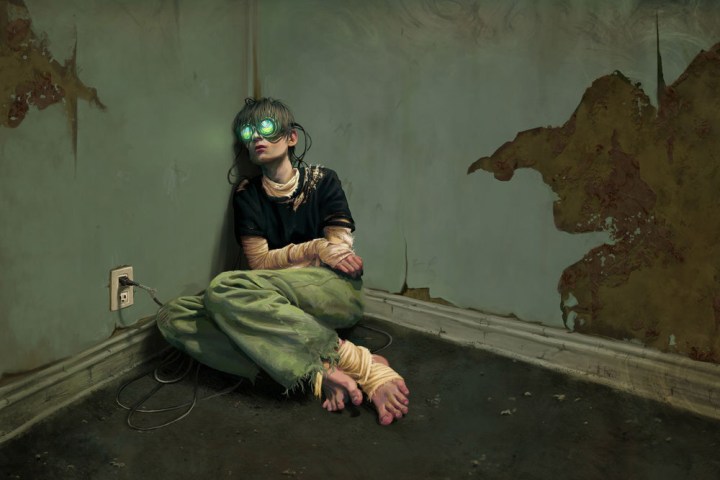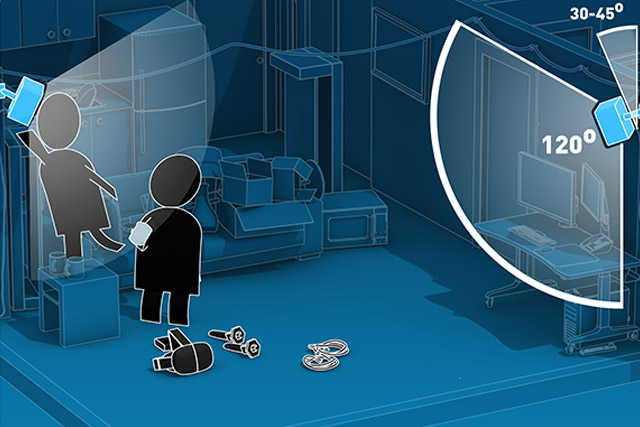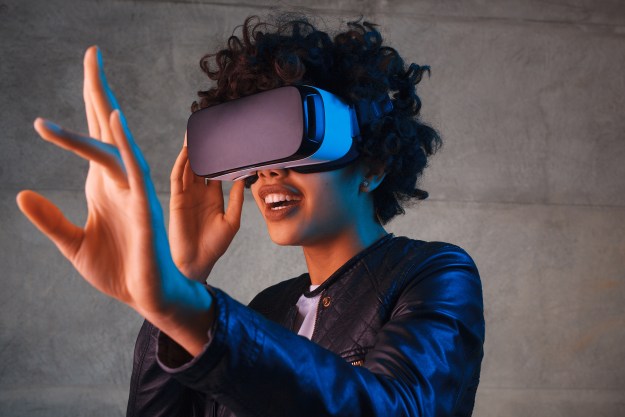
The image above is among the most prolific speculative art about the future of virtual reality. Drawn by Eran Folio, it shows a young man ensconced in his VR headset, surrounded by peeling walls, wearing shabby clothes, living an existence that suggests little else matters but his virtual world.
With luck, none of us will live like this anytime soon. Still, there’s a lot to learn from the image. Notice, for example, that the room is completely empty.
It’s impossible to say when the necessary innovation will happen. Perhaps a clever engineer will find a way next year — or perhaps it will take a decade.
The young man in the picture doesn’t need any furniture, since he has everything he needs in the virtual world. That’s meant as a metaphorical statement on gaming, consumption and modern society. Yet it also has bearing on reality.
One day we will all work in virtual offices, and watch TV through VR goggles, rather than on a screen on the wall. And if you could go to a virtual office looking smart while actually dressed in your bathrobe, who is going to complain?
There’s also a practical aspect. Virtual reality puts a barrier between the young man and the real world. He can’t see what’s happening around him, which means it’s dangerous for anything to happen around him. It’s better to clear the room, make it free from obstacles.
Valve recently gave credit to this theoretical future when it released its set-up guide for the HTV Vive headset. Among its instructions and tips, it suggested clearing a large space to walk around in.
That makes sense. You don’t want to trip over anything or ram your (probably) expensive VR headset into something. But are we really going to dismantle our living rooms every time we want to break out the VR goggles?
Don’t sweat it just yet
It’s probably best you don’t rush out and turn your child’s room into a desolate holodeck. First, we need to see what the initial wave of commercial VR hardware is actually like. None of it is even set to arrive in the hands of the earliest early adopters until the end of next month.

Likewise, HTC has made a point of saying it will support room-scale experiences right out of the box in spaces that separate the two Lighthouse sensors by up to five meters — but it will also operate perfectly well within a two meters by two meters space. That’s much more achievable than the larger ones we’ve seen some developers play with.
Also worth considering is that the content landscape for the first six months — at least until Oculus releases its Touch controllers — is likely to be dominated by seated, forward-facing experiences. That’s the style of gameplay Oculus has been pushing, and most of its imitators follow the same path. The released date for HTC’s Vive, the obvious exception, remains unknown.
A seated experience is the most achievable one for most people in terms of set up, and that’s what developers have mostly been working on. There will be some dedicated people at launch who can play amazing games in giant open spaces, but if you’re not in that group, don’t fret. Most experiences will still be within your reach.
However, it’s worth considering that the VR market will be very different just a few years from now. Millions of people will have headsets, and as the technology becomes more popular, fans will become more willing to make sacrifices to accommodate it.
But does that mean we’ll need giant, desolate rooms where we game away on our lonesome in?
Crafting a VR Room
If there does come a point when you want to build a space that is designed with VR in mind, it needn’t look like a scene from Trainspotting. Although a virtual reality room does, by its very design, require plenty of floor space, it needn’t be bare. Theoretically if the room is big enough, you can have plenty pressed against the walls. Book cases, shelving, chests of drawers – as long as they are against the wall and an open area exists between it all for you to wander and flail in, that should do the job nicely.
Wall hangings, lighting, windows, ornaments — none of this need get in the way of a VR space. Indeed, it may be that as televisions become less prevalent, living room design merely changes to reflect our new passions. Instead of circling our sofas and chairs around a fire or large panel TV, we might circle them around the center of the room, where a friend or relative might be wailing away at a digital orc.
While this might seem like an accident waiting to happen, we have already seen impressive developments, like the Vive’s chaperon system, which let people who are within and without VR to coexist in the same space without fear of getting accidentally hit with a motion controller.
The same goes for pets and simple objects. While it wouldn’t be wise to put your priceless Ming vase on a three legged table in the center of your VR space, it isn’t inconceivable to imagine a lounge of the future with a VR space laden with a rubber mat, while the rest of the room continues as before around it.
Going without?
Unlike other forms of technology, virtual reality — especially at room scale — will always require a reasonable amount of space. Whether it’s two-by-two meters, five-by-five, or something much grander, there are many homes that just don’t have enough free space. Space has always been at a premium, and that’s not likely to change soon. There’s no technological solution to the fact large houses, apartments, and condos are expensive.
There’s no technological solution to the fact large houses, apartments, and condos are expensive.
That’s an important point in this debate. It’s the reason why, despite the HTC Vive’s impressive early demonstrations, Oculus is designing its launch titles and experiences around a seated, or at the very least, forward-facing experience — because that’s what most people’s homes can handle.
The VR room idea takes things a few years down the road when the idea of having a dedicated VR space won’t necessarily be so strange, but when you are talking about the physical limitations of people’s homes, it seems very likely that most content produced for VR, at least for the foreseeable future, will cater to those in smaller spaces as much as larger ones – which means a VR room will not be a necessity.
It may be that certain games and experiences cater to small living quarters. In-development titles like Hover Junkers have specifically-designed ships with smaller spaces in mind. It stands to reason that most games of the future will do something similar.
Yes, there is certainly an advantage to having a bigger space to play in. It aids immersion, and there is likely to be the odd premium games experience that is augmented by having room to move around in. But video games, like everything else, is driven by commercial interests.

That means that if the money is in smaller-scale experiences and games, that’s where most of the effort will be, too.
Will it take off at all?
Will room-scale virtual reality ever become popular? Is it feasible to expect lots of people to dedicate portions of even one room to such a set up?
Perhaps not, especially when you consider the likes of the Void, Derren Brown’s Thorpe Park ghost train, and other projects are seeking to offer VR experiences on a large scale that almost nobody in the world will be able to replicate at home.
Virtual reality — especially at room scale — will always require a reasonable amount of space.
Room scale virtual reality has the potential for some amazing experiences, but it will always be limited by the physical restrictions of the space available. To offer something much larger than the limited space a single room may have, you’ll need something more akin to the Virtuix Omni, which offers truly boundless virtual reality in a much smaller footprint than the multi-square-meter space the first generation VR headsets can operate in.
Room-scale virtual reality will require an invention that lets the user fell like they’re moving in the real world, while only moving in the virtual one, before the experience becomes practical. In the meantime, seated VR will rule.
It’s impossible to say when the necessary innovation will happen. Perhaps a clever engineer will find a way next year — or perhaps it will take a decade. Let’s just hope we don’t need to string ourselves up like Lawnmower Man to make it work.
Editors' Recommendations
- Your Quest 3 just got so much better — for free
- You really do not want to forget your Vision Pro passcode
- How this new Quest VR app totally sold me on exercising in virtual reality
- This futuristic haptic vest should make virtual reality feel more realistic
- The future of immersive VR? ‘Chemical haptics’ applied to your skin




